Analysis of Marx's Argument in The Communist Manifesto Essay
VerifiedAdded on 2023/06/05
|7
|1818
|102
Essay
AI Summary
This essay analyzes Karl Marx and Friedrich Engels's 'The Communist Manifesto,' focusing on Marx's argument that capitalism corrupts the proletariat beyond just their work. The essay begins with the historical context, including Marx's background and his collaboration with Engels, and provides an overview of the manifesto's key arguments. It examines the core concepts of class struggle, the bourgeoisie versus the proletariat, and the inherent contradictions within capitalism that lead to exploitation, inequality, and alienation. The essay highlights Marx's critique of capitalism as a system driven by profit, leading to the commodification of labor and the suppression of workers' rights. It concludes with a summary of Marx's vision of a communist revolution and the eventual elimination of class conflict, exploitation, and inequality. The essay emphasizes the lasting influence of the manifesto as a critical analysis of capitalism and its effects on the working class.
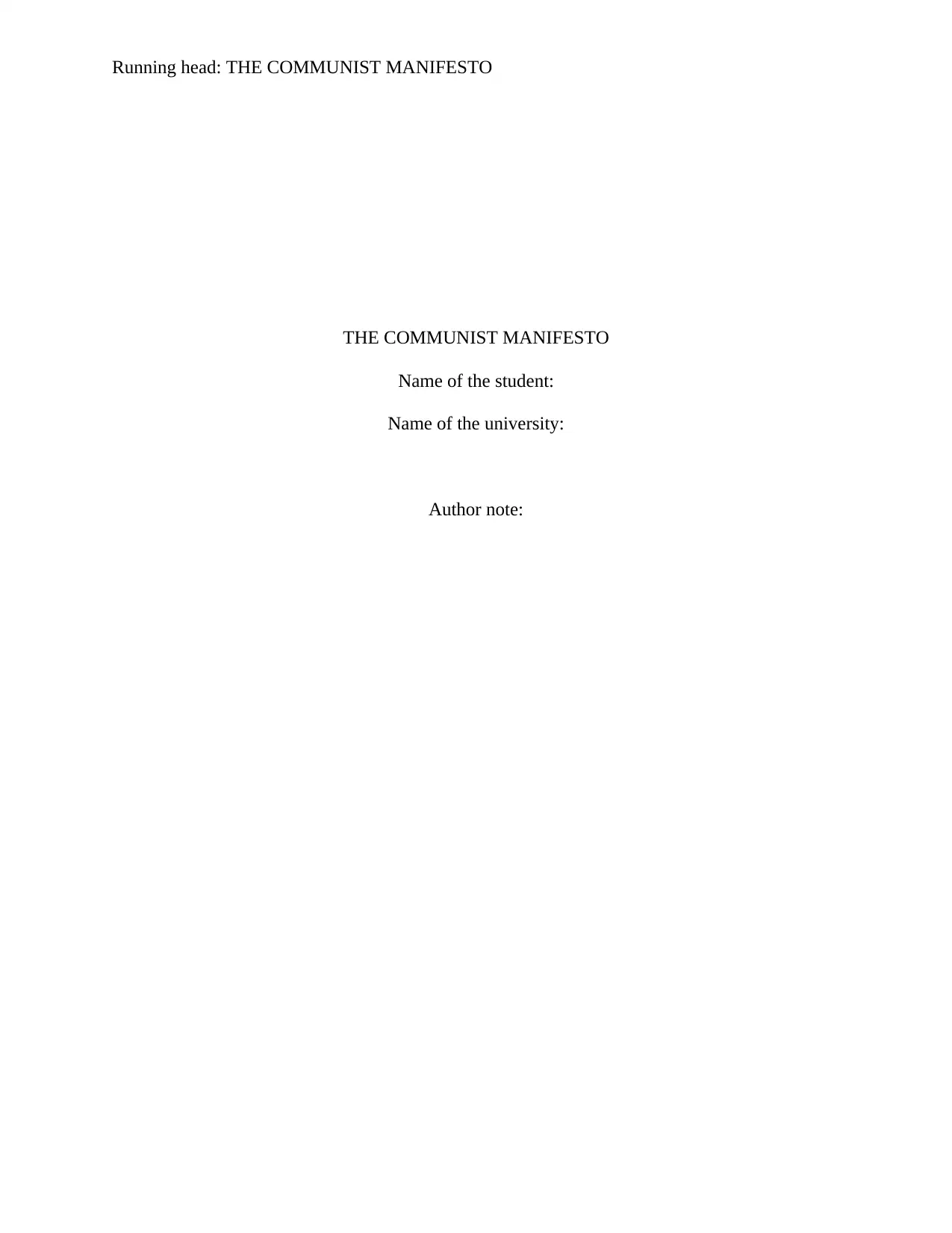
Running head: THE COMMUNIST MANIFESTO
THE COMMUNIST MANIFESTO
Name of the student:
Name of the university:
Author note:
THE COMMUNIST MANIFESTO
Name of the student:
Name of the university:
Author note:
Paraphrase This Document
Need a fresh take? Get an instant paraphrase of this document with our AI Paraphraser
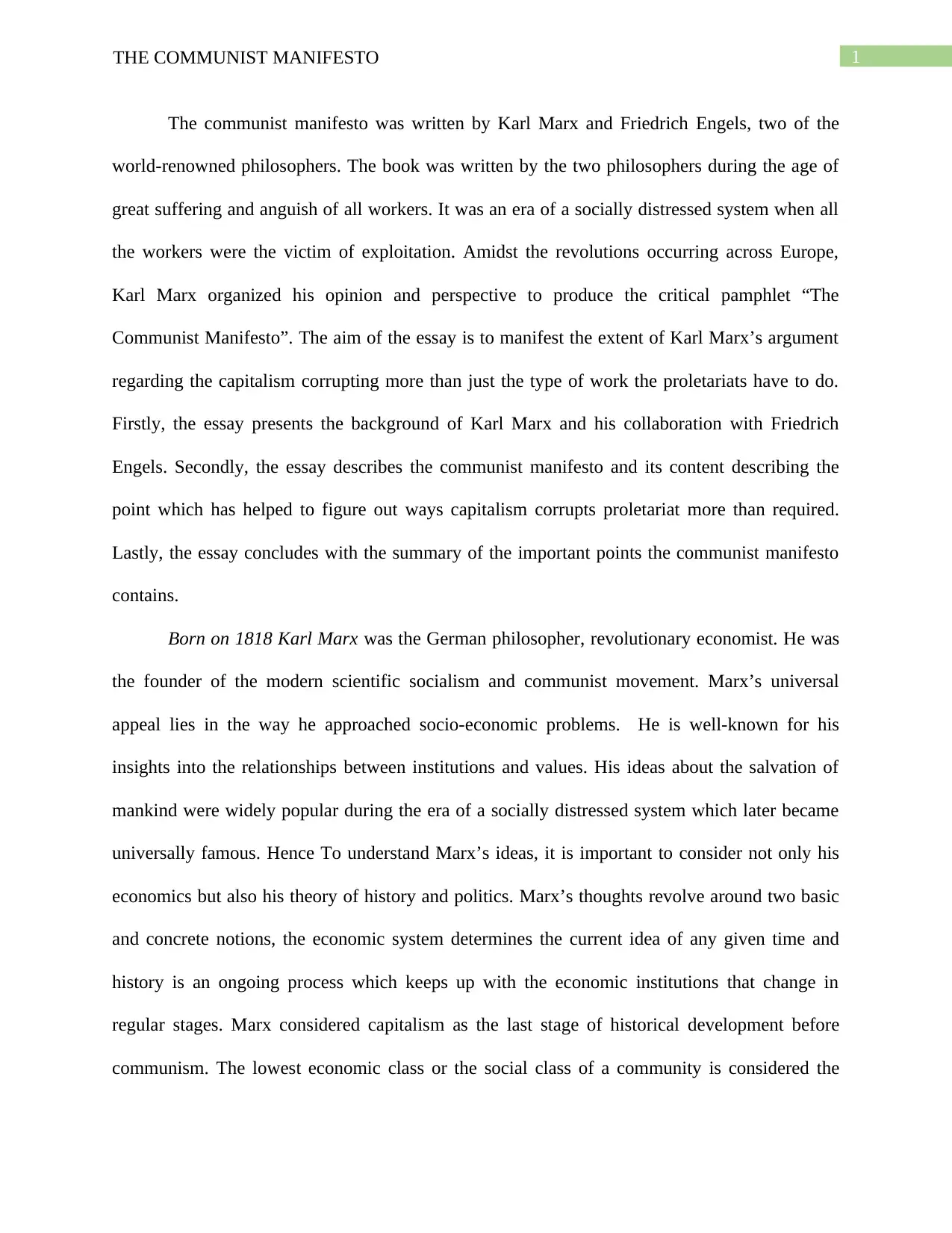
1THE COMMUNIST MANIFESTO
The communist manifesto was written by Karl Marx and Friedrich Engels, two of the
world-renowned philosophers. The book was written by the two philosophers during the age of
great suffering and anguish of all workers. It was an era of a socially distressed system when all
the workers were the victim of exploitation. Amidst the revolutions occurring across Europe,
Karl Marx organized his opinion and perspective to produce the critical pamphlet “The
Communist Manifesto”. The aim of the essay is to manifest the extent of Karl Marx’s argument
regarding the capitalism corrupting more than just the type of work the proletariats have to do.
Firstly, the essay presents the background of Karl Marx and his collaboration with Friedrich
Engels. Secondly, the essay describes the communist manifesto and its content describing the
point which has helped to figure out ways capitalism corrupts proletariat more than required.
Lastly, the essay concludes with the summary of the important points the communist manifesto
contains.
Born on 1818 Karl Marx was the German philosopher, revolutionary economist. He was
the founder of the modern scientific socialism and communist movement. Marx’s universal
appeal lies in the way he approached socio-economic problems. He is well-known for his
insights into the relationships between institutions and values. His ideas about the salvation of
mankind were widely popular during the era of a socially distressed system which later became
universally famous. Hence To understand Marx’s ideas, it is important to consider not only his
economics but also his theory of history and politics. Marx’s thoughts revolve around two basic
and concrete notions, the economic system determines the current idea of any given time and
history is an ongoing process which keeps up with the economic institutions that change in
regular stages. Marx considered capitalism as the last stage of historical development before
communism. The lowest economic class or the social class of a community is considered the
The communist manifesto was written by Karl Marx and Friedrich Engels, two of the
world-renowned philosophers. The book was written by the two philosophers during the age of
great suffering and anguish of all workers. It was an era of a socially distressed system when all
the workers were the victim of exploitation. Amidst the revolutions occurring across Europe,
Karl Marx organized his opinion and perspective to produce the critical pamphlet “The
Communist Manifesto”. The aim of the essay is to manifest the extent of Karl Marx’s argument
regarding the capitalism corrupting more than just the type of work the proletariats have to do.
Firstly, the essay presents the background of Karl Marx and his collaboration with Friedrich
Engels. Secondly, the essay describes the communist manifesto and its content describing the
point which has helped to figure out ways capitalism corrupts proletariat more than required.
Lastly, the essay concludes with the summary of the important points the communist manifesto
contains.
Born on 1818 Karl Marx was the German philosopher, revolutionary economist. He was
the founder of the modern scientific socialism and communist movement. Marx’s universal
appeal lies in the way he approached socio-economic problems. He is well-known for his
insights into the relationships between institutions and values. His ideas about the salvation of
mankind were widely popular during the era of a socially distressed system which later became
universally famous. Hence To understand Marx’s ideas, it is important to consider not only his
economics but also his theory of history and politics. Marx’s thoughts revolve around two basic
and concrete notions, the economic system determines the current idea of any given time and
history is an ongoing process which keeps up with the economic institutions that change in
regular stages. Marx considered capitalism as the last stage of historical development before
communism. The lowest economic class or the social class of a community is considered the
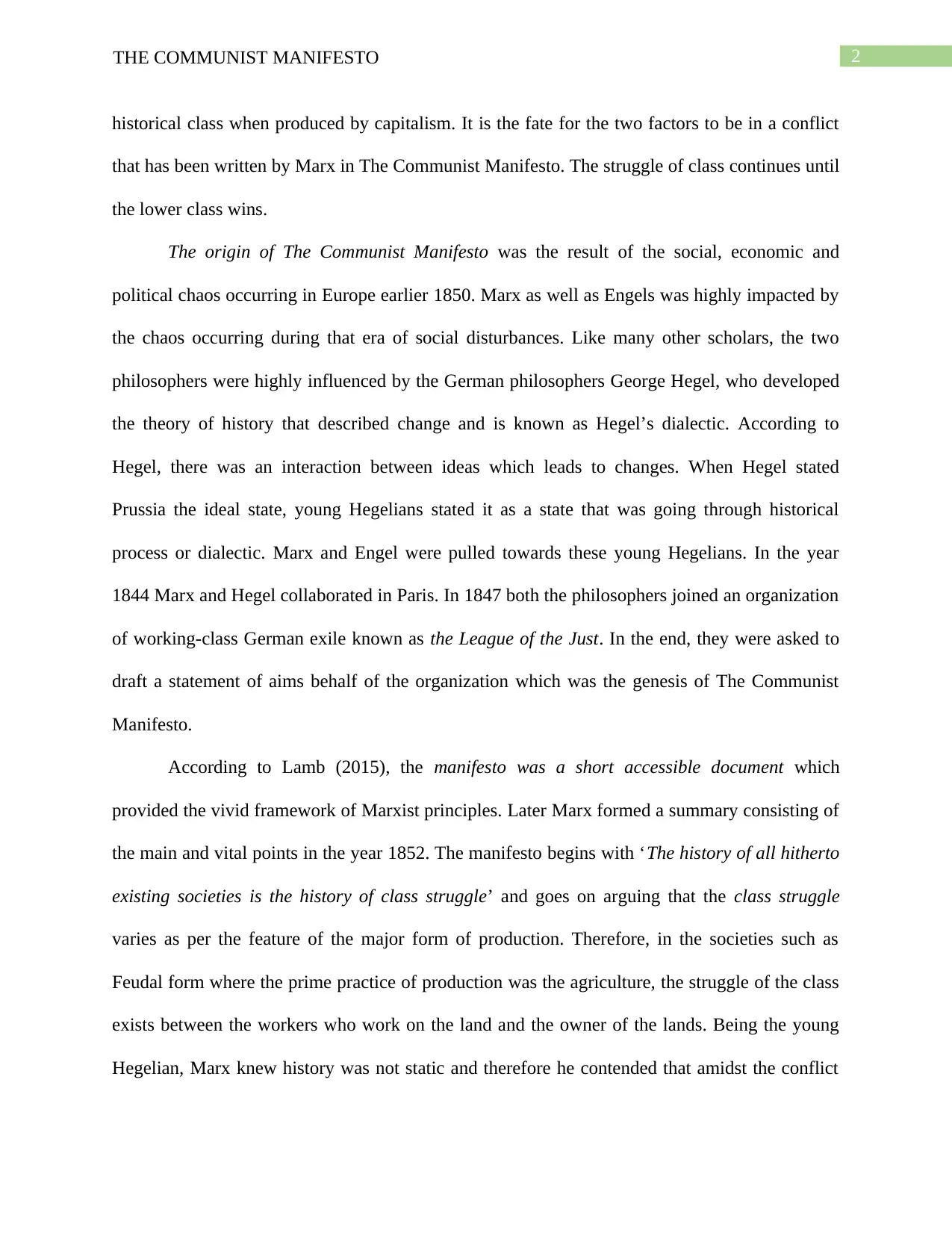
2THE COMMUNIST MANIFESTO
historical class when produced by capitalism. It is the fate for the two factors to be in a conflict
that has been written by Marx in The Communist Manifesto. The struggle of class continues until
the lower class wins.
The origin of The Communist Manifesto was the result of the social, economic and
political chaos occurring in Europe earlier 1850. Marx as well as Engels was highly impacted by
the chaos occurring during that era of social disturbances. Like many other scholars, the two
philosophers were highly influenced by the German philosophers George Hegel, who developed
the theory of history that described change and is known as Hegel’s dialectic. According to
Hegel, there was an interaction between ideas which leads to changes. When Hegel stated
Prussia the ideal state, young Hegelians stated it as a state that was going through historical
process or dialectic. Marx and Engel were pulled towards these young Hegelians. In the year
1844 Marx and Hegel collaborated in Paris. In 1847 both the philosophers joined an organization
of working-class German exile known as the League of the Just. In the end, they were asked to
draft a statement of aims behalf of the organization which was the genesis of The Communist
Manifesto.
According to Lamb (2015), the manifesto was a short accessible document which
provided the vivid framework of Marxist principles. Later Marx formed a summary consisting of
the main and vital points in the year 1852. The manifesto begins with ‘The history of all hitherto
existing societies is the history of class struggle’ and goes on arguing that the class struggle
varies as per the feature of the major form of production. Therefore, in the societies such as
Feudal form where the prime practice of production was the agriculture, the struggle of the class
exists between the workers who work on the land and the owner of the lands. Being the young
Hegelian, Marx knew history was not static and therefore he contended that amidst the conflict
historical class when produced by capitalism. It is the fate for the two factors to be in a conflict
that has been written by Marx in The Communist Manifesto. The struggle of class continues until
the lower class wins.
The origin of The Communist Manifesto was the result of the social, economic and
political chaos occurring in Europe earlier 1850. Marx as well as Engels was highly impacted by
the chaos occurring during that era of social disturbances. Like many other scholars, the two
philosophers were highly influenced by the German philosophers George Hegel, who developed
the theory of history that described change and is known as Hegel’s dialectic. According to
Hegel, there was an interaction between ideas which leads to changes. When Hegel stated
Prussia the ideal state, young Hegelians stated it as a state that was going through historical
process or dialectic. Marx and Engel were pulled towards these young Hegelians. In the year
1844 Marx and Hegel collaborated in Paris. In 1847 both the philosophers joined an organization
of working-class German exile known as the League of the Just. In the end, they were asked to
draft a statement of aims behalf of the organization which was the genesis of The Communist
Manifesto.
According to Lamb (2015), the manifesto was a short accessible document which
provided the vivid framework of Marxist principles. Later Marx formed a summary consisting of
the main and vital points in the year 1852. The manifesto begins with ‘The history of all hitherto
existing societies is the history of class struggle’ and goes on arguing that the class struggle
varies as per the feature of the major form of production. Therefore, in the societies such as
Feudal form where the prime practice of production was the agriculture, the struggle of the class
exists between the workers who work on the land and the owner of the lands. Being the young
Hegelian, Marx knew history was not static and therefore he contended that amidst the conflict
⊘ This is a preview!⊘
Do you want full access?
Subscribe today to unlock all pages.

Trusted by 1+ million students worldwide
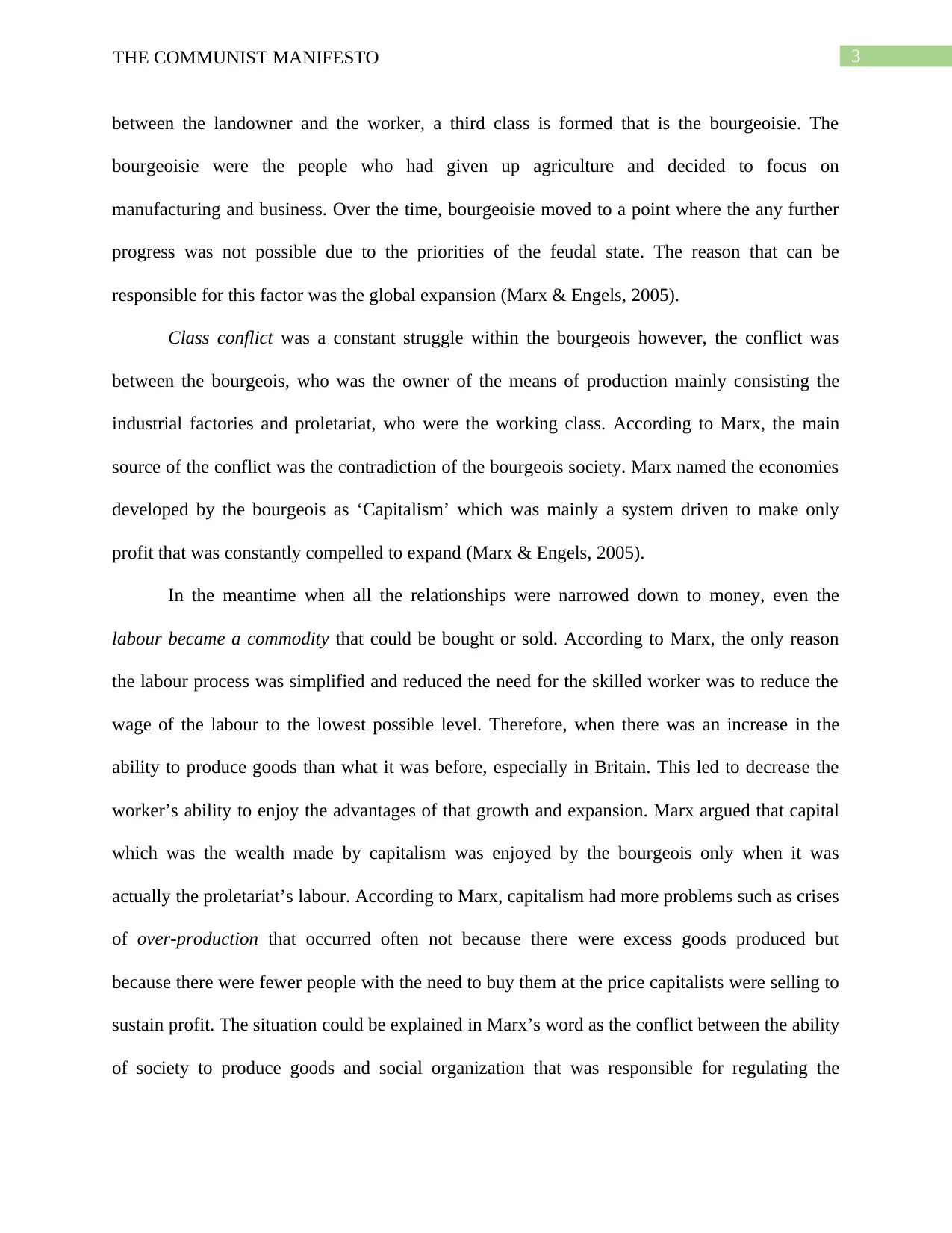
3THE COMMUNIST MANIFESTO
between the landowner and the worker, a third class is formed that is the bourgeoisie. The
bourgeoisie were the people who had given up agriculture and decided to focus on
manufacturing and business. Over the time, bourgeoisie moved to a point where the any further
progress was not possible due to the priorities of the feudal state. The reason that can be
responsible for this factor was the global expansion (Marx & Engels, 2005).
Class conflict was a constant struggle within the bourgeois however, the conflict was
between the bourgeois, who was the owner of the means of production mainly consisting the
industrial factories and proletariat, who were the working class. According to Marx, the main
source of the conflict was the contradiction of the bourgeois society. Marx named the economies
developed by the bourgeois as ‘Capitalism’ which was mainly a system driven to make only
profit that was constantly compelled to expand (Marx & Engels, 2005).
In the meantime when all the relationships were narrowed down to money, even the
labour became a commodity that could be bought or sold. According to Marx, the only reason
the labour process was simplified and reduced the need for the skilled worker was to reduce the
wage of the labour to the lowest possible level. Therefore, when there was an increase in the
ability to produce goods than what it was before, especially in Britain. This led to decrease the
worker’s ability to enjoy the advantages of that growth and expansion. Marx argued that capital
which was the wealth made by capitalism was enjoyed by the bourgeois only when it was
actually the proletariat’s labour. According to Marx, capitalism had more problems such as crises
of over-production that occurred often not because there were excess goods produced but
because there were fewer people with the need to buy them at the price capitalists were selling to
sustain profit. The situation could be explained in Marx’s word as the conflict between the ability
of society to produce goods and social organization that was responsible for regulating the
between the landowner and the worker, a third class is formed that is the bourgeoisie. The
bourgeoisie were the people who had given up agriculture and decided to focus on
manufacturing and business. Over the time, bourgeoisie moved to a point where the any further
progress was not possible due to the priorities of the feudal state. The reason that can be
responsible for this factor was the global expansion (Marx & Engels, 2005).
Class conflict was a constant struggle within the bourgeois however, the conflict was
between the bourgeois, who was the owner of the means of production mainly consisting the
industrial factories and proletariat, who were the working class. According to Marx, the main
source of the conflict was the contradiction of the bourgeois society. Marx named the economies
developed by the bourgeois as ‘Capitalism’ which was mainly a system driven to make only
profit that was constantly compelled to expand (Marx & Engels, 2005).
In the meantime when all the relationships were narrowed down to money, even the
labour became a commodity that could be bought or sold. According to Marx, the only reason
the labour process was simplified and reduced the need for the skilled worker was to reduce the
wage of the labour to the lowest possible level. Therefore, when there was an increase in the
ability to produce goods than what it was before, especially in Britain. This led to decrease the
worker’s ability to enjoy the advantages of that growth and expansion. Marx argued that capital
which was the wealth made by capitalism was enjoyed by the bourgeois only when it was
actually the proletariat’s labour. According to Marx, capitalism had more problems such as crises
of over-production that occurred often not because there were excess goods produced but
because there were fewer people with the need to buy them at the price capitalists were selling to
sustain profit. The situation could be explained in Marx’s word as the conflict between the ability
of society to produce goods and social organization that was responsible for regulating the
Paraphrase This Document
Need a fresh take? Get an instant paraphrase of this document with our AI Paraphraser
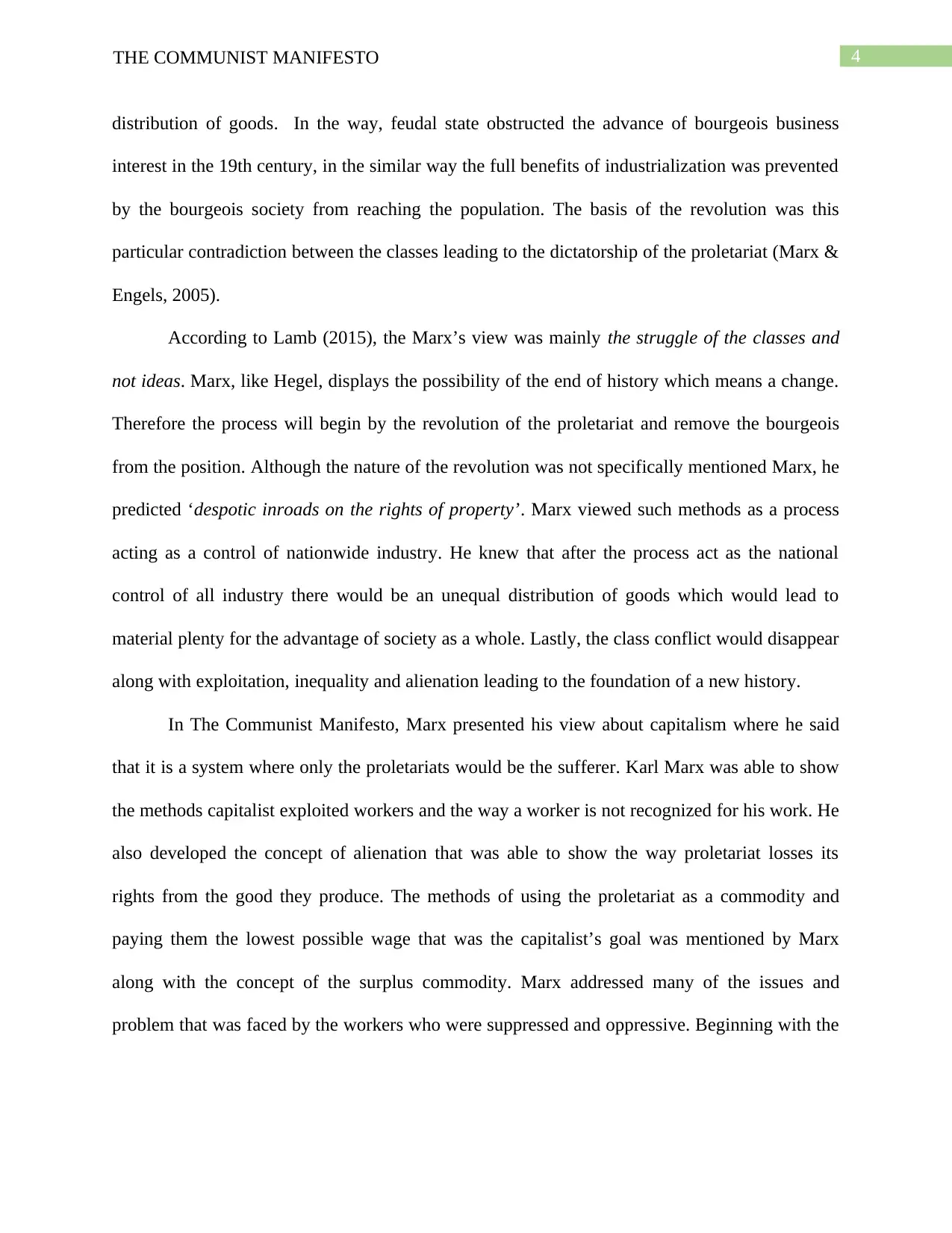
4THE COMMUNIST MANIFESTO
distribution of goods. In the way, feudal state obstructed the advance of bourgeois business
interest in the 19th century, in the similar way the full benefits of industrialization was prevented
by the bourgeois society from reaching the population. The basis of the revolution was this
particular contradiction between the classes leading to the dictatorship of the proletariat (Marx &
Engels, 2005).
According to Lamb (2015), the Marx’s view was mainly the struggle of the classes and
not ideas. Marx, like Hegel, displays the possibility of the end of history which means a change.
Therefore the process will begin by the revolution of the proletariat and remove the bourgeois
from the position. Although the nature of the revolution was not specifically mentioned Marx, he
predicted ‘despotic inroads on the rights of property’. Marx viewed such methods as a process
acting as a control of nationwide industry. He knew that after the process act as the national
control of all industry there would be an unequal distribution of goods which would lead to
material plenty for the advantage of society as a whole. Lastly, the class conflict would disappear
along with exploitation, inequality and alienation leading to the foundation of a new history.
In The Communist Manifesto, Marx presented his view about capitalism where he said
that it is a system where only the proletariats would be the sufferer. Karl Marx was able to show
the methods capitalist exploited workers and the way a worker is not recognized for his work. He
also developed the concept of alienation that was able to show the way proletariat losses its
rights from the good they produce. The methods of using the proletariat as a commodity and
paying them the lowest possible wage that was the capitalist’s goal was mentioned by Marx
along with the concept of the surplus commodity. Marx addressed many of the issues and
problem that was faced by the workers who were suppressed and oppressive. Beginning with the
distribution of goods. In the way, feudal state obstructed the advance of bourgeois business
interest in the 19th century, in the similar way the full benefits of industrialization was prevented
by the bourgeois society from reaching the population. The basis of the revolution was this
particular contradiction between the classes leading to the dictatorship of the proletariat (Marx &
Engels, 2005).
According to Lamb (2015), the Marx’s view was mainly the struggle of the classes and
not ideas. Marx, like Hegel, displays the possibility of the end of history which means a change.
Therefore the process will begin by the revolution of the proletariat and remove the bourgeois
from the position. Although the nature of the revolution was not specifically mentioned Marx, he
predicted ‘despotic inroads on the rights of property’. Marx viewed such methods as a process
acting as a control of nationwide industry. He knew that after the process act as the national
control of all industry there would be an unequal distribution of goods which would lead to
material plenty for the advantage of society as a whole. Lastly, the class conflict would disappear
along with exploitation, inequality and alienation leading to the foundation of a new history.
In The Communist Manifesto, Marx presented his view about capitalism where he said
that it is a system where only the proletariats would be the sufferer. Karl Marx was able to show
the methods capitalist exploited workers and the way a worker is not recognized for his work. He
also developed the concept of alienation that was able to show the way proletariat losses its
rights from the good they produce. The methods of using the proletariat as a commodity and
paying them the lowest possible wage that was the capitalist’s goal was mentioned by Marx
along with the concept of the surplus commodity. Marx addressed many of the issues and
problem that was faced by the workers who were suppressed and oppressive. Beginning with the
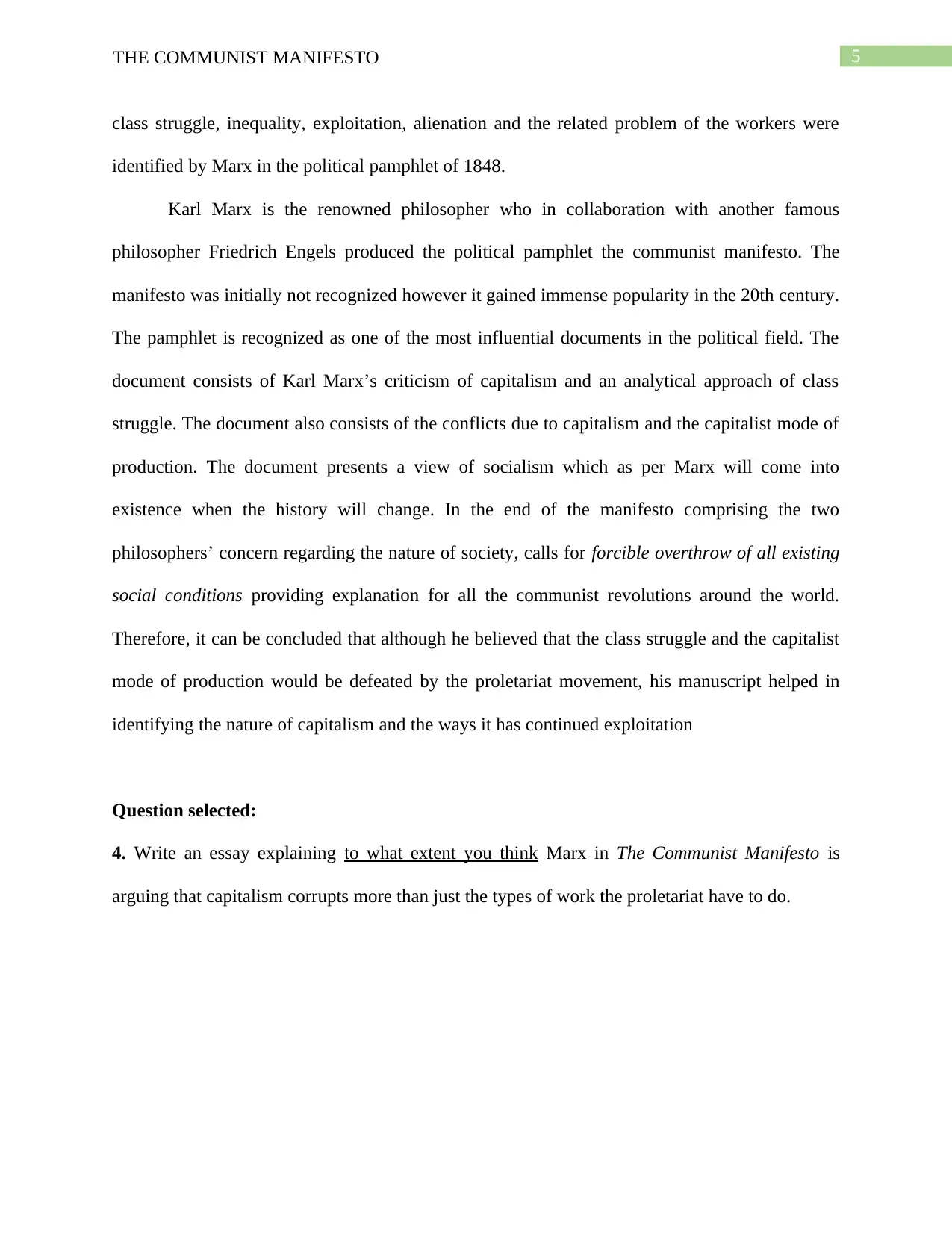
5THE COMMUNIST MANIFESTO
class struggle, inequality, exploitation, alienation and the related problem of the workers were
identified by Marx in the political pamphlet of 1848.
Karl Marx is the renowned philosopher who in collaboration with another famous
philosopher Friedrich Engels produced the political pamphlet the communist manifesto. The
manifesto was initially not recognized however it gained immense popularity in the 20th century.
The pamphlet is recognized as one of the most influential documents in the political field. The
document consists of Karl Marx’s criticism of capitalism and an analytical approach of class
struggle. The document also consists of the conflicts due to capitalism and the capitalist mode of
production. The document presents a view of socialism which as per Marx will come into
existence when the history will change. In the end of the manifesto comprising the two
philosophers’ concern regarding the nature of society, calls for forcible overthrow of all existing
social conditions providing explanation for all the communist revolutions around the world.
Therefore, it can be concluded that although he believed that the class struggle and the capitalist
mode of production would be defeated by the proletariat movement, his manuscript helped in
identifying the nature of capitalism and the ways it has continued exploitation
Question selected:
4. Write an essay explaining to what extent you think Marx in The Communist Manifesto is
arguing that capitalism corrupts more than just the types of work the proletariat have to do.
class struggle, inequality, exploitation, alienation and the related problem of the workers were
identified by Marx in the political pamphlet of 1848.
Karl Marx is the renowned philosopher who in collaboration with another famous
philosopher Friedrich Engels produced the political pamphlet the communist manifesto. The
manifesto was initially not recognized however it gained immense popularity in the 20th century.
The pamphlet is recognized as one of the most influential documents in the political field. The
document consists of Karl Marx’s criticism of capitalism and an analytical approach of class
struggle. The document also consists of the conflicts due to capitalism and the capitalist mode of
production. The document presents a view of socialism which as per Marx will come into
existence when the history will change. In the end of the manifesto comprising the two
philosophers’ concern regarding the nature of society, calls for forcible overthrow of all existing
social conditions providing explanation for all the communist revolutions around the world.
Therefore, it can be concluded that although he believed that the class struggle and the capitalist
mode of production would be defeated by the proletariat movement, his manuscript helped in
identifying the nature of capitalism and the ways it has continued exploitation
Question selected:
4. Write an essay explaining to what extent you think Marx in The Communist Manifesto is
arguing that capitalism corrupts more than just the types of work the proletariat have to do.
⊘ This is a preview!⊘
Do you want full access?
Subscribe today to unlock all pages.

Trusted by 1+ million students worldwide
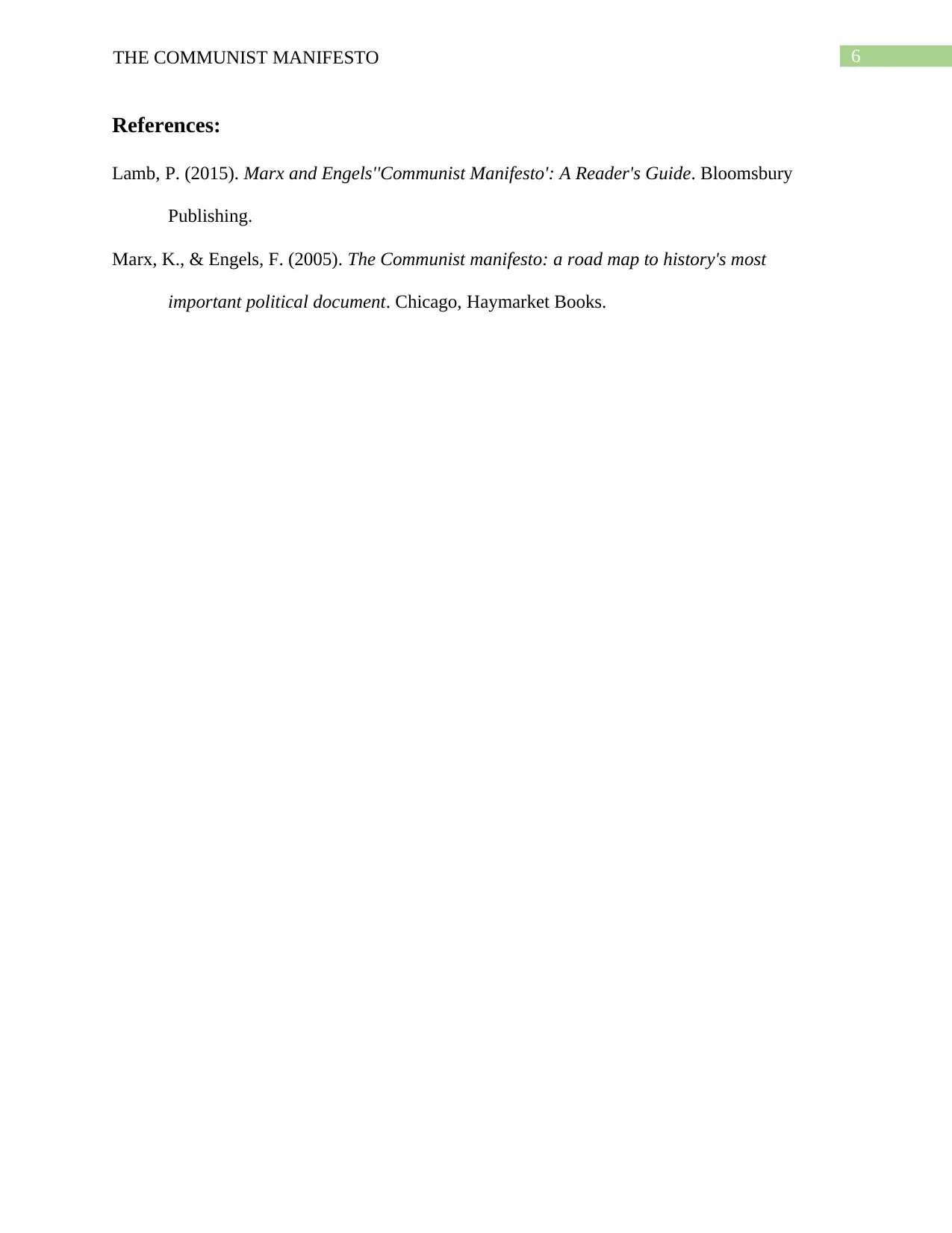
6THE COMMUNIST MANIFESTO
References:
Lamb, P. (2015). Marx and Engels''Communist Manifesto': A Reader's Guide. Bloomsbury
Publishing.
Marx, K., & Engels, F. (2005). The Communist manifesto: a road map to history's most
important political document. Chicago, Haymarket Books.
References:
Lamb, P. (2015). Marx and Engels''Communist Manifesto': A Reader's Guide. Bloomsbury
Publishing.
Marx, K., & Engels, F. (2005). The Communist manifesto: a road map to history's most
important political document. Chicago, Haymarket Books.
1 out of 7
Related Documents
Your All-in-One AI-Powered Toolkit for Academic Success.
+13062052269
info@desklib.com
Available 24*7 on WhatsApp / Email
![[object Object]](/_next/static/media/star-bottom.7253800d.svg)
Unlock your academic potential
Copyright © 2020–2025 A2Z Services. All Rights Reserved. Developed and managed by ZUCOL.





